 |
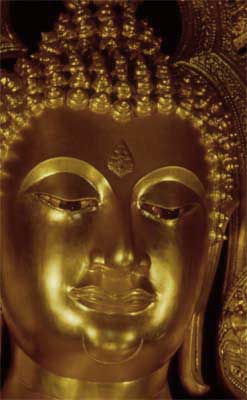
A closeup of the very famous Phraphuttachinarat shows a very high refinement in the creation of stylized facial features. |
|
|
ภาคฉบับภาษาไทย
|
Thai Contemporary Art
|
Thai Mural Painting
|
Introduction |
|
It is important to spend enough time, when looking at these big statues, to be able to absorb the expression that radiates from them. They posses an obviously refined character, but the sense of pervasiveness may take some time to manifest. It’s a good idea to sit silently for some time in front of them. Just by looking, eventually, the elements of form and proportion will come together and yield an effect of rhythmic, outward radiance. The anonymous people who worked on Phrasrisakaya Munee for almost two centuries were nothing less than the greatest artists. The scale of the presiding Buddha image is really quite large. So it is easy to feel overwhelmed just by its immense size. Perhaps this is why most people don’t even seem to look at it for very long. The longer I look at it, the more the artistic elements in the sculpture begin to come together. Ultimately, it is one large, whole work of magnificent sculpture. |
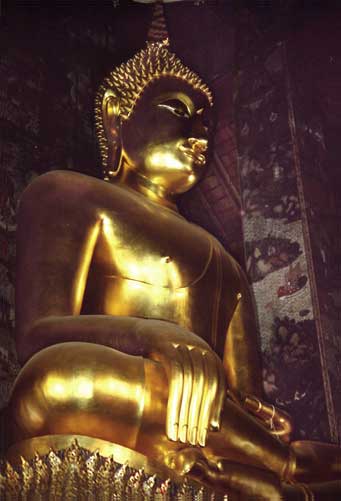 Standing at ground level the sculpture Phrasrisakaya Munee towers above. |
The artistic elements of Phrasrisakaya Munee are unified. The proportion is very well balanced too. The head, shoulders, torso and legs are part of a body, which has a credible shape. At the same time, these parts work in concert to make a whole organic form. No one part obviously dominates another, which yields a harmonious balance. The over all look is unique. Buddha seems to be alive watching and participating with us. And he’s a giant who sits with us in the same room. Artistically, there are two types of line to consider when analyzing this antique work of art. Thai artists refer to this first line as san tang trong.7 This is the centerline that connects the top of the flame on Buddha’s head to the base. It is a line of symmetry. The balance between right and left is also symbolic of the Buddhist concept of the middle path. Never reaching for extremes, peace comes from balancing the opposing sides. This idea is implicitly reflected in the symmetry of the facial features. The second line to consider is the outline of the form. It is a dramatically curved contour. This line is a refinement of shape that is repeated as a motif in all aspect of the parts. |
|
The facial features have dramatic lines in the lips and eyes, and the wrists have major curves that come down to form the fingers. The shoulders, arms, hands, legs and feet all have this swinging arched line.8 It is intended to represent the kindness and mercy of the Buddha, as well as the kindness that all Thais expect from each other. The Sukhothai Buddha image has a very beautiful mass especially in the volume of the face, chest, torso, and waist. The arms are intended to mimic the bulk in the trunk of an elephant. To see the distribution of mass you must steep back far enough from to view the entire sculpture at once. As the light falls upon it, you will be able to see the volume. The anatomy, quality of line, and massive scale mix together wonderfully. These are some of the qualities that made the Sukhothai artists different from the Sri Lankan school. These techniques were developed generation by generation until these elements came together in a new style. So much so, that no other Thai sculptural style is considered more beautiful than the Sukhothai style. 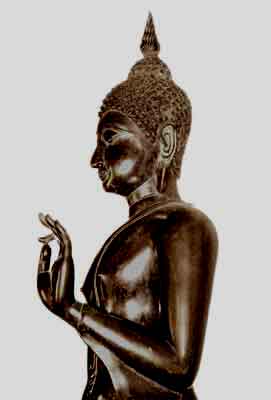 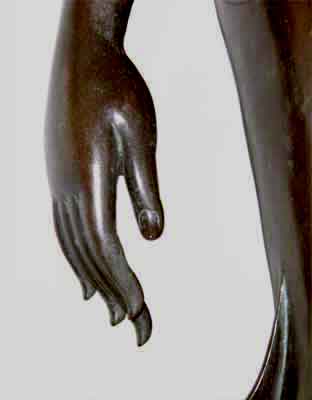 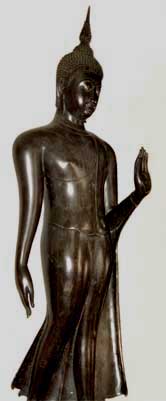
The identifying characteristics of a Sukhothai Buddha image are:
|
 |
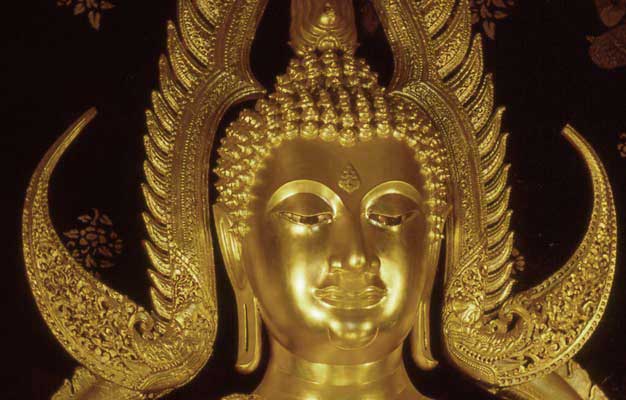 |
|
The third king of the Phra Raung Dynasty, king Ramkamhaeng is hailed as the inventor of the Thai alphabet and a benevolent king possessing wisdom in the fields of government and justice. He never taxed his subjects and he encouraged free trade. He hung a bell in a public area so that anyone with a complaint could ring it and appeal directly to him. A devout Buddhist, he commissioned the construction of many temples and sculptures, including Phrasrisakaya Munee. Because of his merit, people still practice Theravada Buddhism to this day.1 This period in Thai history is documented as having an abundance of things economic, agrarian, cultural, governmental and religious. As these statues were made within a religious context, they represent the beliefs of this culture. This now extinct civilization must have had a connection between the cultural and phenomenal worlds, for in the art they left behind, one can only bask in the reflection of harmony that this society must have possessed. |
| ||||||
Content supervisor & writer: Pakorn Prohmvitak Site design & writer: Sam Forkner All rights reserved. The content on Thai Art Magazine may be reproduced with express consent from SamForkner dot Org. Copyright © 2005, 2011 Bangkok, Thailand. |
||||||
